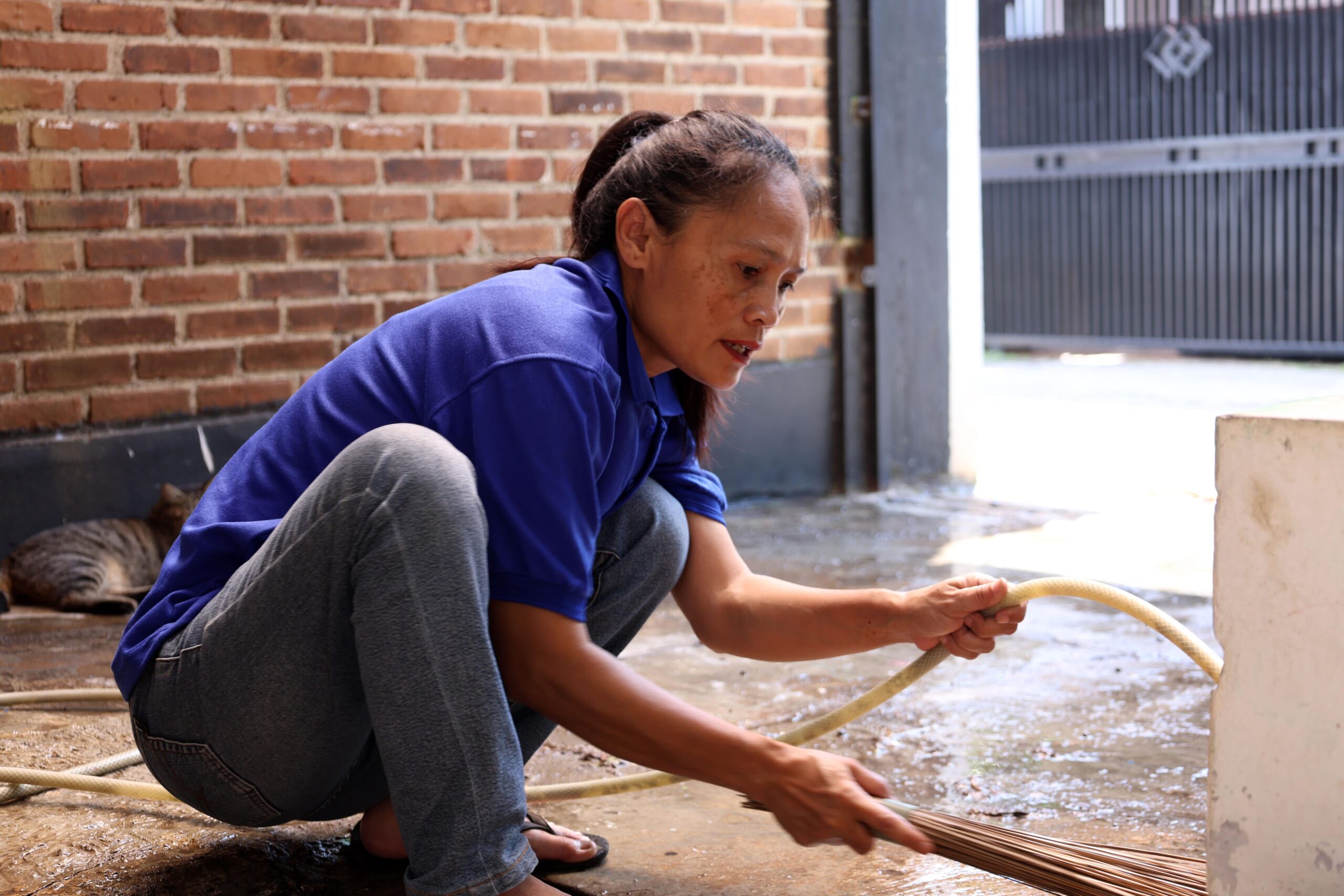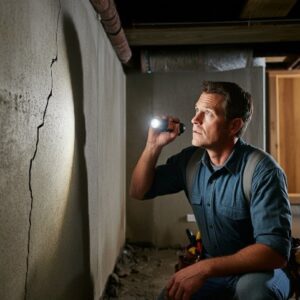Dealing with wet basement solutions is more than just drying out a damp floor. It’s more about protecting your home from long-term damage. A wet basement can lead to mold growth, foundation issues, and costly repairs if ignored.
Why does this happen?
Sometimes, it’s as simple as poor drainage around your home. Other times, it’s a more serious issue like foundation cracks or high groundwater levels. Regardless of the cause, finding the right solution is the most important thing.
So, what can you do about it?
Let’s start by understanding what’s causing the problem in the first place.
Common Causes of a Wet Basement
If you’re dealing with water in the basement, the first step is identifying the cause.
Moisture can enter through cracks, faulty drainage, or even rising groundwater. Ignoring the problem can lead to water damage, mold growth, and expensive basement repair.
The Environmental Protection Agency (EPA) recommends maintaining indoor humidity levels between 30% and 50% to prevent mold growth and moisture issues in basements.
Here are the most common reasons for a wet basement and how to spot them.
Poor Drainage and Grading
Water should always flow away from your foundation, but if your yard is sloped incorrectly, rainwater can pool near your home, which could lead to a leaky basement.
Check for standing water around your foundation after a storm—if it’s not draining properly, you may need to adjust your landscaping or install a drainage system.
Cracks in Basement Walls and Floor
Even small foundation cracks can allow water infiltration, especially after heavy rains. Over time, these cracks widen, which leads to a flooded basement.
Inspect your basement floor and walls for visible cracks. If you see moisture seeping in, it’s time to consider foundation repair and waterproofing.
Faulty or Clogged Gutters and Downspouts
Your gutters and downspouts play a key role in keeping the basement dry.
If they are clogged, water can spill over and saturate the ground near your home and potentially cause leaks.
But sometimes, water finds its way inside through less obvious entry points. Homeowners often overlook hidden leaks that let moisture in, which leads to dampness and mold growth. Learn about the not-so-obvious ways water gets in so you can protect your basement from sneaky leaks before they become a bigger problem.
Also, make sure downspouts extend at least 4 feet away from your foundation to prevent water intrusion.
High Water Table and Hydrostatic Pressure
If your home is in a low-lying area or near a water source, high groundwater levels can force water into your basement.
This pressure, called hydrostatic pressure, pushes water through tiny gaps in the foundation.
Signs include damp basement walls, standing water, or a constantly running sump pump.
How to Identify the Source of a Wet Basement
Here is how to identify the source of a wet basement:
- Look for water stains on basement walls and floor.
- Check for condensation or a musty smell, which are often a good indicator of excess moisture.
- Inspect the exterior grading and make sure water is flowing away from the house.
- Test your sump pump to ensure it’s functioning properly.
Understanding these basement issues is the first step in finding wet basement solutions.
In the next section, we’ll explore DIY basement waterproofing methods to help you dry out your basement and prevent future leaks.
DIY Wet Basement Solutions
If you have a wet basement, there are several DIY basement waterproofing solutions that can help keep it dry and leak-free. While some basement repair services require professional help, these waterproofing solutions can be done by homeowners looking for a cost-effective way to prevent water in the basement.
Fixing Foundation Cracks
Small cracks in basement floors and walls can allow water to enter your basement.
Using epoxy injections or hydraulic cement can seal these cracks and stop further leaks. If you notice widespread foundation damage, it may be time for a basement foundation repair contractor to step in.
Improving Exterior Drainage
Poor drainage is a major cause of basement leaks. To divert water away from the foundation, make sure your gutters and downspouts are clean and directing water at least 4 feet from your home.
If you have frequent pooling near your foundation, consider installing a French drain or exterior waterproofing system.
Applying Waterproofing Paints & Sealers
A quick way to keep your basement dry is to apply waterproofing sealers to basement walls and floors.
These coatings create a moisture barrier, but they are most effective when used with other waterproofing methods like proper drainage.
Using a Dehumidifier
If your basement moisture issue is caused by high humidity, a dehumidifier can help. It reduces dampness, prevents mold, and improves air quality.
This is a simple way to maintain a dry basement environment.
When Is DIY Basement Waterproofing Sufficient?
DIY methods work well for minor leaks, high humidity, and surface-level moisture problems.
However, if you’re dealing with a flooded basement, major foundation issues, or continuous water infiltration, hiring a basement waterproofing contractor is the best option.
Now, we’ll explore professional basement waterproofing services and when they’re necessary.
Professional Wet Basement Solutions
Sometimes, DIY basement waterproofing solutions aren’t enough. If you have persistent water in your basement, visible foundation cracks, or a flooded basement, it’s time to call a basement waterproofing contractor.
Professional services provide long-term solutions that keep your basement dry and protect your home from water damage.
Interior Drainage Systems
For ongoing water problems, interior drainage systems like French drains and sump pumps are highly effective.
A sump pump collects and removes water in the basement, which prevents flooding.
Installing a drainage system inside your basement helps direct water away from your foundation before it causes serious damage.
However, regular maintenance is crucial to keep your sump pump working properly. A neglected sump pump can fail when you need it most and leave you with a flooded basement.
Check out this guide on sump pump maintenance to ensure yours stays in top shape year-round.
Exterior Basement Waterproofing
Exterior basement waterproofing services involve applying waterproof membranes and improving drainage around your home.
One of the most effective ways to manage excess water is by using a weeping tile system. Many homeowners aren’t familiar with what exactly weeping tile is and why it is important, but it plays a huge role in keeping basements dry. This drainage system helps redirect water away from your home’s foundation and prevents water buildup and leaks.
While costly, it ensures water stays out of your basement permanently.
Installing a Vapor Barrier
A vapor barrier prevents moisture from seeping through basement walls and floors. If your basement feels damp even without visible leaks, this is a cost-effective waterproofing service to reduce basement moisture.
Foundation Repair Methods
If your home has serious foundation issues, methods like piering and underpinning can stabilize your basement walls and prevent future leaks. These repairs are essential if you notice major cracks or shifting in your home’s structure.
Cost of Professional Basement Waterproofing
The cost of basement waterproofing varies based on the method used:
- Sump pump installation: $800 – $2,500
- French drain system: $2,000 – $6,000
- Exterior waterproofing: $5,000 – $15,000
- Foundation repair: $3,500 – $10,000
Preventing Future Basement Moisture Problems
Fixing a wet basement is just the beginning.
To ensure it stays dry for years to come, homeowners need to take proactive steps to prevent future water damage. A combination of proper drainage, regular maintenance, and early detection can help you avoid costly basement repair services.
One of the most effective ways to prevent water in the basement is by maintaining your gutters and downspouts. Clogged or damaged gutters can cause water to pool around your foundation, which increases the risk of leaks.
Cleaning gutters regularly and making sure downspouts extend at least four feet away from your home can significantly reduce the chances of water intrusion. Proper landscaping also plays a crucial role.
Sloping the ground away from your foundation and installing gravel trenches or French drains can direct water away and improve overall basement waterproofing.
A damp basement is often the result of poor ventilation. Using dehumidifiers and fans can help regulate humidity levels and prevent mold growth. Additionally, conducting annual inspections is a simple yet crucial step in preventing basement leaks. Checking for foundation cracks, water stains, or sump pump issues at least once a year can help catch small problems before they become major basement repair expenses.
Conclusion
A wet basement can lead to serious water damage if left untreated. Taking action early is key to maintaining a dry basement regardless of whether it’s fixing small cracks, improving drainage, or investing in professional basement waterproofing.
If you’re facing persistent basement leaks, trust Shield Foundation Repair for expert waterproofing solutions.
With 35 years of experience, a transferable lifetime warranty, and top-rated service in Edmonton and Northern Alberta, Shield provides reliable basement repair services.
Contact Shield Foundation Repair today for a free quote and protect your home for years to come.





